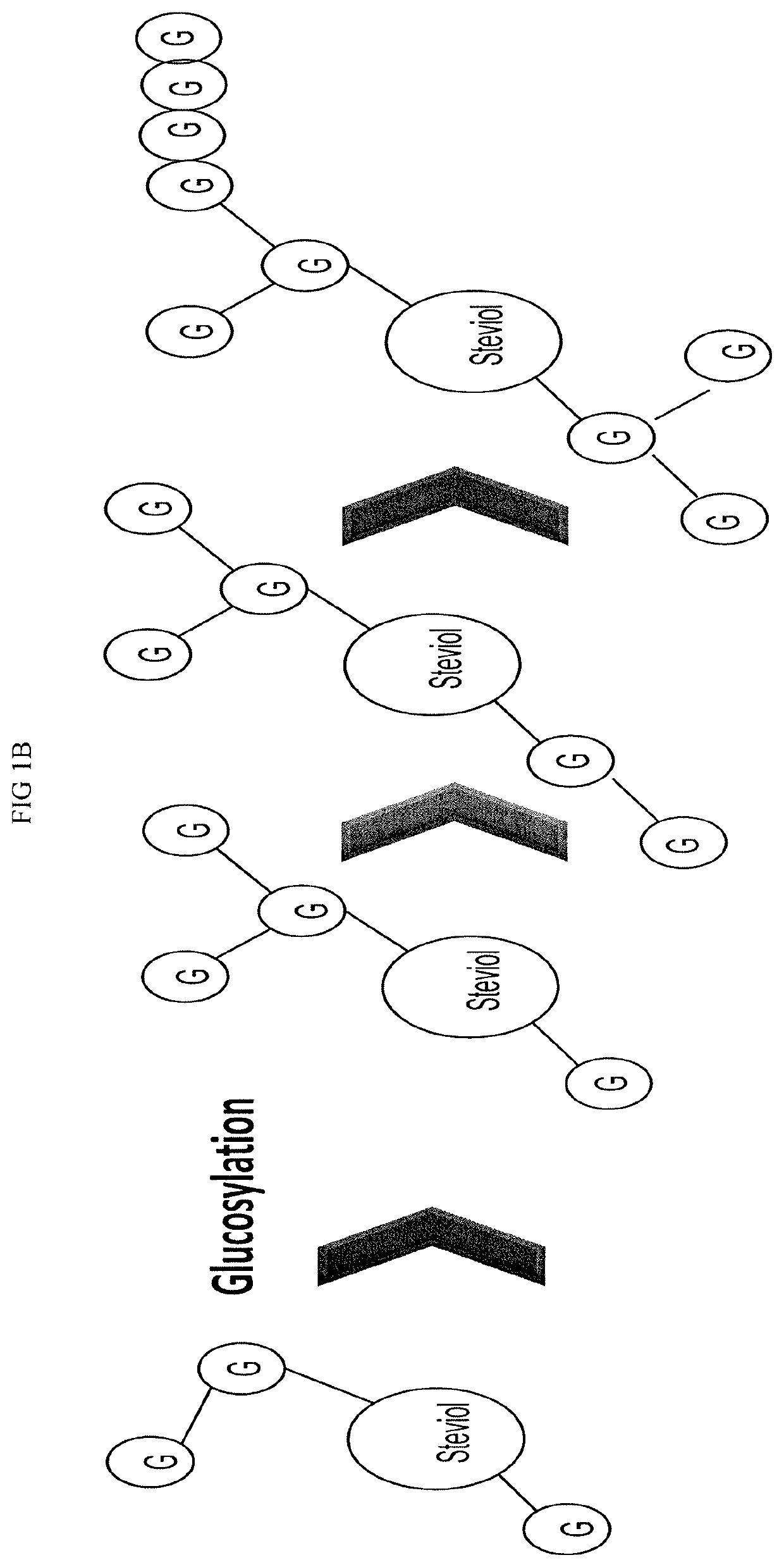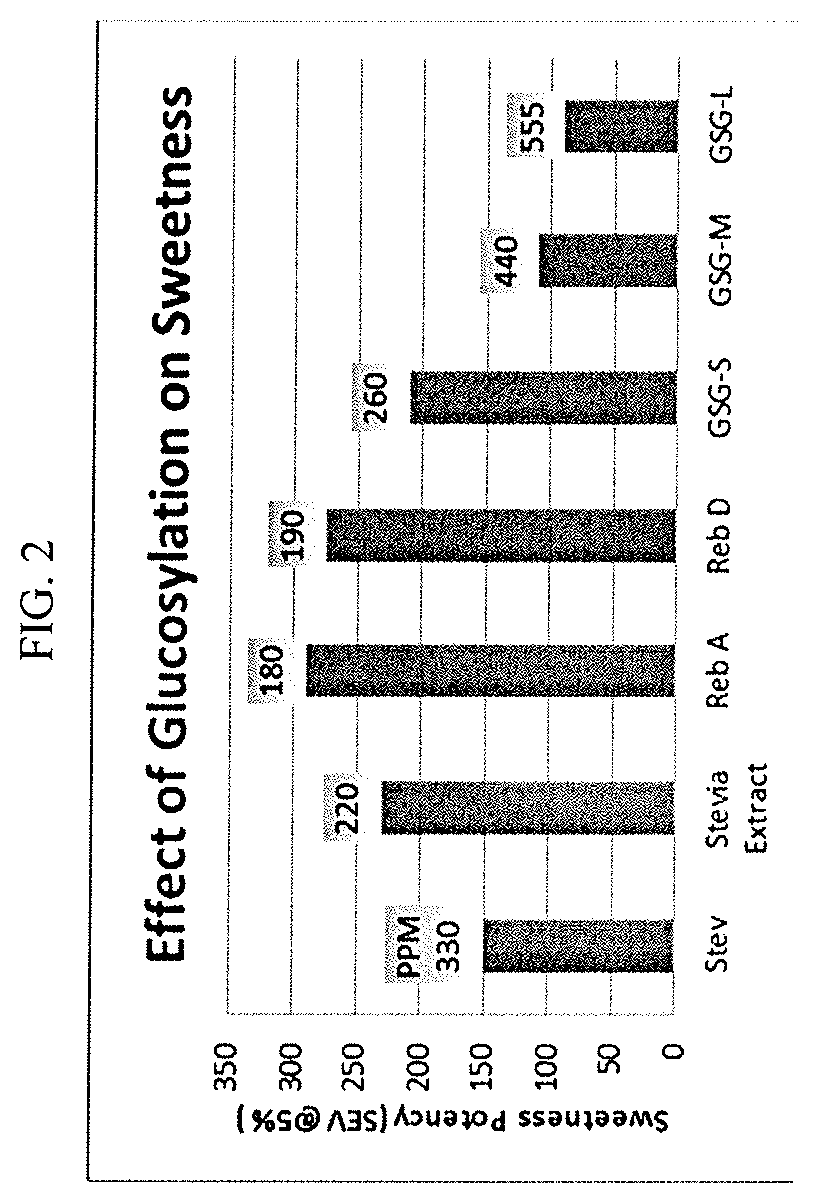Glucosylated steviol glycoside as a flavor modifier
a technology of glucosylated steviol and glycoside, which is applied in the field of glucosylated steviol glycoside compositions, can solve the problems of unsatisfactory taste characteristics of glycosides, and achieve the effect of improving composition
- Summary
- Abstract
- Description
- Claims
- Application Information
AI Technical Summary
Benefits of technology
Problems solved by technology
Method used
Image
Examples
example 1
Preparation of the Blend of Steviol Glycosides and Glucosylated Steviol Glycosides
[0044]Several compositions containing blends of different GSG and SG components were prepared from stevia extract and starch. The samples as outlined below were produced by treating the raw materials, steviol glycosides extracted from the Stevia plant, and starch extracted from tapioca, with a natural enzyme. The enzyme transfers glucose units from starch to the steviol glycosides. The enzyme used to facilitate this transfer is produced by means of fermentation using non-GMO (non-genetically modified organism) bacteria. Specifically, FIG. 1A illustrates the single glycosylation (G1) of a stevioside molecule. This process can yield multiple glycosylation (G2, G3, etc.) of different steviol glycosides (mainly stevioside and Rebaudioside A) present in stevia extract as shown in FIG. 1B.
[0045]Manufacturing steps for blends of GSG and SG[0046]a) Tapioca starch is dissolved in RO water and liquefied by CGTas...
example 2
Evaluation of Iso-Sweetness of Different Blends of GSG & SG
[0052]To determine the concentration of the blends (Table 1) at which barely any sweetness perception is detected, a series of samples of each blend (Concentration ranging between 40 mg / L and 140 mg / L) were prepared and tested against 1% sugar solution. The test parameters and results are outlined in Tables 2 & 3, respectively.
TABLE 2Methodology used for determining the iso-sweetness of blends at 1% sugar solutionNature of Participants:Company employeesNumber of Sessions1Number of Participants:25Test Design:2- AFC, Balanced, randomizedwithin pair. BlindSensory Test Method:Intensity ratingsEnvironmental ConditionStandard booth lightingAttributes and Scales:Which sample is sweeter?Statistical Analysis:Paired comparison TestSample Size~1.5 oz. in a clear capped plastic cupServing TemperatureRoom temperature (~70° F.)Serving / PanelistsSamples served simultaneously.Instruction:Panelists instructed to readingredient statement,evalu...
example 3
[0053]Evaluation and Comparison of Sweetness of the GSG+SG Composition with Selected Commercial Steviol Glycoside Samples
[0054]To evaluate the iso-sweetness of steviol glycosides (SG) and glucosylated steviol glycosides (GSG), a series of stevia derived samples were selected as shown in Table 4. To evaluate the sweetness potency of various concentrations of stevia products in aqueous solutions, aqueous solutions of sugar, stevioside, Rebaudioside A (Reb A), Rebaudioside D (Reb D), GSG-S (contains mainly smaller GSGs with 1 or 2 glucose units added to SG), GSG-M and GSG-L at various concentrations were prepared using bottled water. Samples were evaluated by the judges at room temperature (70-72° F.).
TABLE 4Glucosylated Steviol ResidualGlycosides with Stevioladded glucose unitTestMolecularSteviolGlyco-G1 &IngredientsWt (avg)equivalentsidesG2G3-G9G10-G20Stevioside 8050.396>99%Reb A 9670.329>99%Reb D11290.282>99%GSG-S12100.26395%GSG-M13800.231 42%50%GSG-L17980.177 19%60%16%
[0055]The jud...
PUM
 Login to View More
Login to View More Abstract
Description
Claims
Application Information
 Login to View More
Login to View More - R&D
- Intellectual Property
- Life Sciences
- Materials
- Tech Scout
- Unparalleled Data Quality
- Higher Quality Content
- 60% Fewer Hallucinations
Browse by: Latest US Patents, China's latest patents, Technical Efficacy Thesaurus, Application Domain, Technology Topic, Popular Technical Reports.
© 2025 PatSnap. All rights reserved.Legal|Privacy policy|Modern Slavery Act Transparency Statement|Sitemap|About US| Contact US: help@patsnap.com



